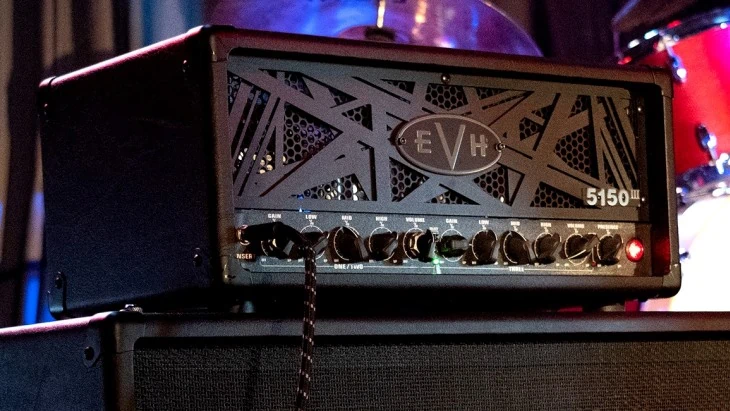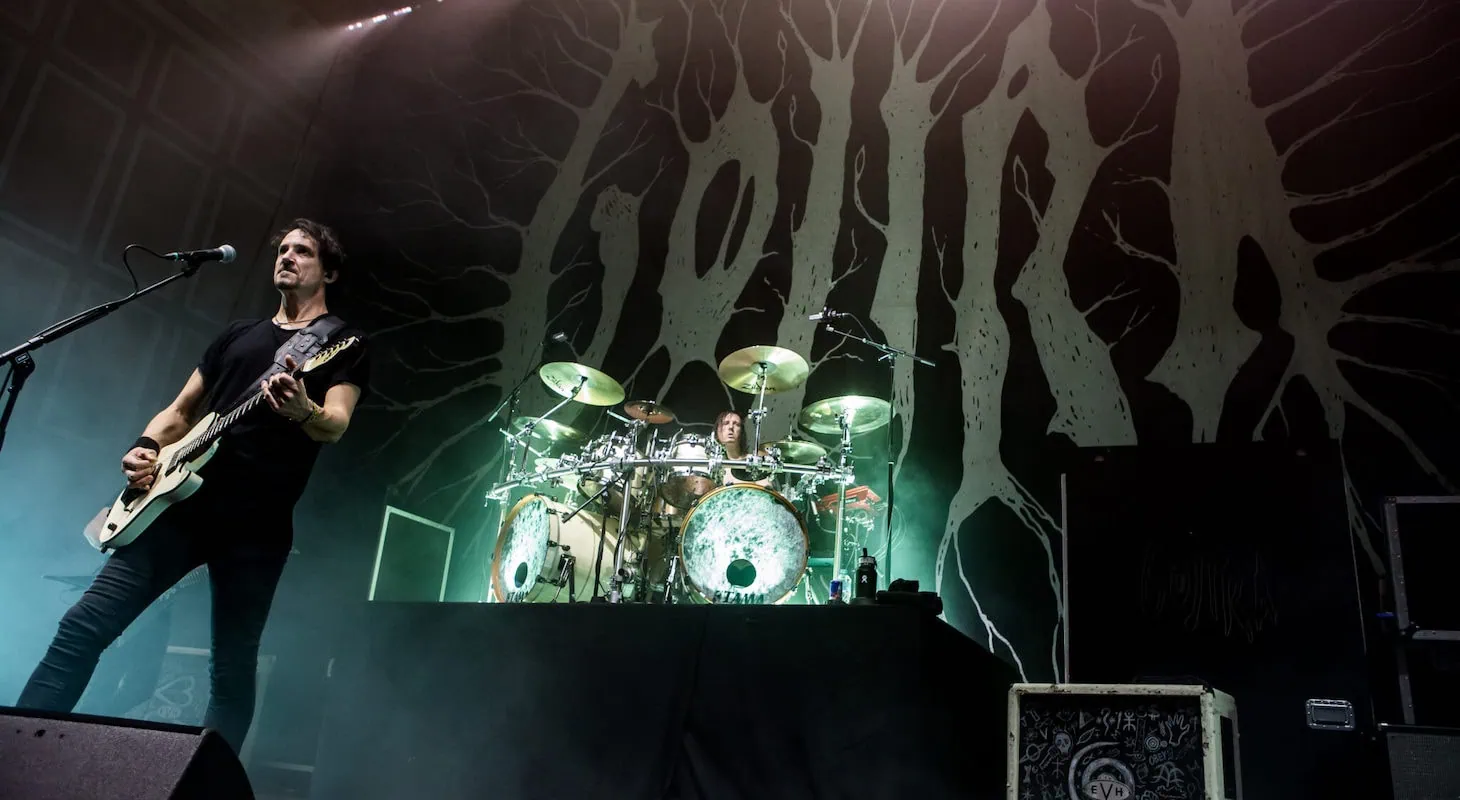I don’t know about you, but I was beyond thrilled to see Gojira’s crushing performance at the Opening Ceremony of the 2024 Olympics. It terrified my grandma and baffled my nephew, but I thought it was awesome.
Their appearance at the Olympics cemented Gojira as the modern era’s premier heavy metal act. With staggering prog-metal riffs and howling tones, Gojira’s music name sounds like their namesake. Big, terrifying, and not to be trifled with.
If Godzilla could play guitar, he’d sound like Gojira.
The Gojira tone really comes from a simple, no-frills setup that allows frontman and guitarist Joe Duplantier’s technique to take center stage. Let’s see how he creates the signature Gojira sound.
Table of Contents
Guitars

Duplantier uses a few different guitars, but his main guitar is his Charvel Signature model. Charvel is a fairly popular brand in metal, with quite a few players sporting their guitars. They’re a Fender subsidiary, so many of their guitars are, for all intents and purposes, hot-rodded Fender classics.
In that vein, Duplantier’s Charvel is a Tele-style guitar. However, unlike the original Telecaster, this isn’t an instrument you’d go to for country twang. Its mahogany neck and ebony fretboard give it some added warmth and depth in comparison to a standard Tele.
There is also a more affordable version of his signature model. This version is also made from mahogany and ebony but has a bit less of a Tele look and uses Seymour Duncan humbuckers instead of DiMarzio.
The Duplantier signature model can be tricky to find, but fortunately there’s no shortage of excellent Charvel Tele-style guitars.
For my shot at replicating his tone, I tried out the Charvel San Dimas Style 2, which comes with Duncan Designed pickups.
The first thing to do is remove these and replace them with Duplantier’s own signature set from DiMarzio.
He has also played Jackson guitars. This makes the Jackson Dinky JS32 a great budget option that will still be able to give you a good Gojira tone. Again, I’d replace the stock pickups with Duplantier’s signature DiMarzios.
Duplantier’s fellow axeman Christian Andreu uses a Jackson Randy Rhoads model.
Occasionally, for guitar solos, the gentlemen of Gojira will wield Gibson guitars like a Flying V or Explorer.
While I was trying to get their tone down, I realised a key part of the Gojira sound is the extensive use of dropped tuning. Drop D, D standard, and Drop C are commonly found on their songs: “Flying Whales,” for example, is in D standard.
The important elements here are:
- Dropped tuning (which means thicker strings like Ernie Ball’s Skinny Top Heavy Bottom set at .10-.52)
- Humbucker pickups, preferably Duplantier’s signature DiMarzios
- Ebony or rosewood fretboard with a high-gain-ready body tonewood like nato, basswood, or mahogany
- Jumbo frets will help with playability for high-speed riffing
Amps

For amps, Duplantier uses both an EVH head and a cab, specifically the EVH 5150III Head and the EVH 5150III Cab. So, too, does Christian Andreu.
These are great amps for metal. They have a heavy, aggressive tone and more than enough power to fill a stadium.
Honestly, I’d recommend the EVH amp for anyone playing heavy music. It was designed by the godfather of high-gain tone himself, Edward Van Halen. It really doesn’t get much better than this for heavy music.
There is a combo version of the 5150III that isn’t as expensive as a full stack. There is also the 5150 Iconic that is more affordable.
Duplantier switches channels on his amp rather than employing overdrive or distortion pedals.
Of course, if you are on a tight budget, a good combo amp like the Marshall MG50GFX will likely get the job done. You could also always go for a quality modeling amp like the BOSS Katana.
Effects
Joe doesn’t use too many effects. Most of his tone comes straight from his guitar and amp.
He does use a few effects during certain sections of songs, as well as some post-processing.
You can definitely hear him use whammy from time to time. But since his guitars don’t have whammy bars, he likely uses a pedal like the Digitech Whammy 5.
For extra overdrive, he recently started using KHDK pedals like the No1 and the Ghoul Screamer. The JHS PackRat and Bonsai are two great alternatives with a wide variety of tones.
For delay, Duplantier uses a classic, the MXR Carbon Copy. This is a great analog delay used by many guitarists, myself included.
The Carbon Copy does have a darker voicing that works well for Gojira’s sound, and it’s mostly used for clean sounds. It’s a little too messy for the high-precision high-gain riffing for which Gojira are best known.
To help keep all of that sound under control, he uses either an MXR Noise Gate or a Boss NS-2.
Gojira Amp Settings
Now that we know what gear to use, let us look at the settings used on his amps.
Joe’s tone is fairly midrange-y. The EQ on his amp is mostly set just past the halfway point.
Round 6 or 7 seems to be where he likes to keep all his EQ for the most part. The lows are dialed back slightly, sometimes to around 4.
The gain varies a bit depending on the song and different parts of songs. He uses very little gain at times. And sometimes, the gain is just below half, and sometimes it is cranked up.
As for volume, that is kept really low. The presence is then turned up quite high.
Your amp settings should then look something like this:
- Bass – 6
- Mids – 6
- Highs – 6
- Volume – 2/3
- Presence – 7/8
Or alternatively:
- Bass – 4
- Mids – 6
- Highs – 6
- Volume – 2/3
- Presence – 7/8
The three settings for gain are 2/3, 6, and 8. The gain setting will depend on how heavy a certain song or part needs to be.
I wouldn’t adjust the gain knob at all between sections. Instead, I’d just switch between the EVH amp’s various gain stages. The 5150 III, after all, is a three-channel amp for a reason: you’re supposed to use it that way.
In fact, it sounds best that way. The built-in gain staging is very satisfying, especially upon switching to the third, most powerful channel. It turns any guitar into a firebreathing heavy metal machine.
Modeling
For those who prefer to play their guitar into a computer, Neural DSP introduced a plugin specifically to capture Gojira’s brutal tones. Archetype: Gojira is also compatible with the Quad Cortex, so you can take it on the road.
Gojira actually use this software themselves, so in a way, using it is like playing Gojira’s actual gear!
Personally, I prefer the satisfying thud and crunch of pushing air with a massive amplifier. However, modern players accustomed to modelers will find plenty to love here.
Extras
You can also put Ernie Ball Skinny Top Heavy Bottom Slinky strings on your guitar. This will help you get those beefy, crunchy riffs and chords while keeping solos and open chords bright. They’ll maintain the appropriate string tension even at the lower pitches required for playing Gojira riffs.
Final Word
And there you go. That should be all you need to know to get Gojira’s signature sound.
But if you have any doubts, just remember to aim for a mid-focused, crunchy, crushing sound.
The Gojira tone, like a lot of prog tones, comes down, for the most part, to the mix, and to technique.
The high-gain tone outlined here is an awesome sound for any heavy metal, but it works best for the kind of high-fidelity riffing Gojira are best known for.
The Gojira pick slide sounds really good at these settings, too. Try it out!


Maybe it’s a little confusing to write here about a Telecaster player. The sound of a Tele comes from its wood and the bridge system. These Tele-Formed guitars here a made from Mahogany, and have a Tune-o-Matic bridge with a bar. So when you want to compare his guitars to a traditional model, we have here an SG-Player.